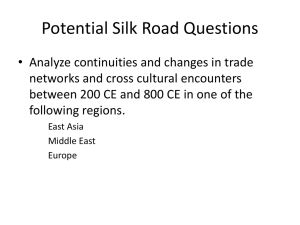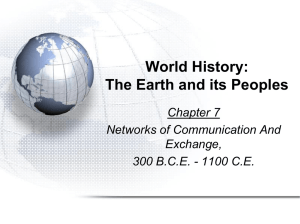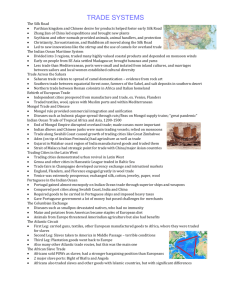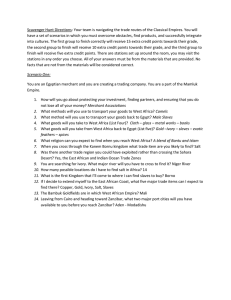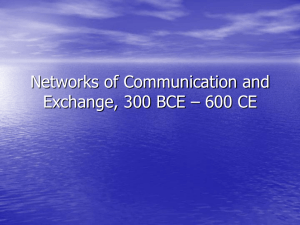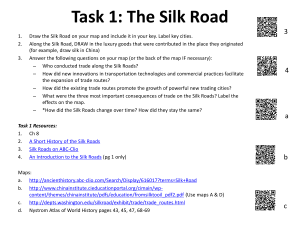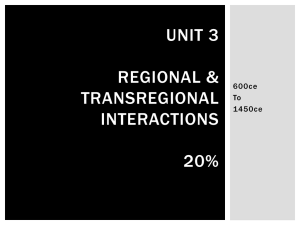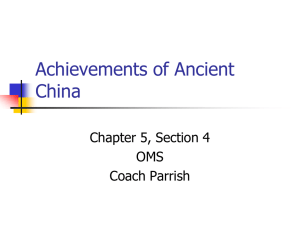Study Sheet: Trade 1. General Features of Trade Partners in a trade
advertisement
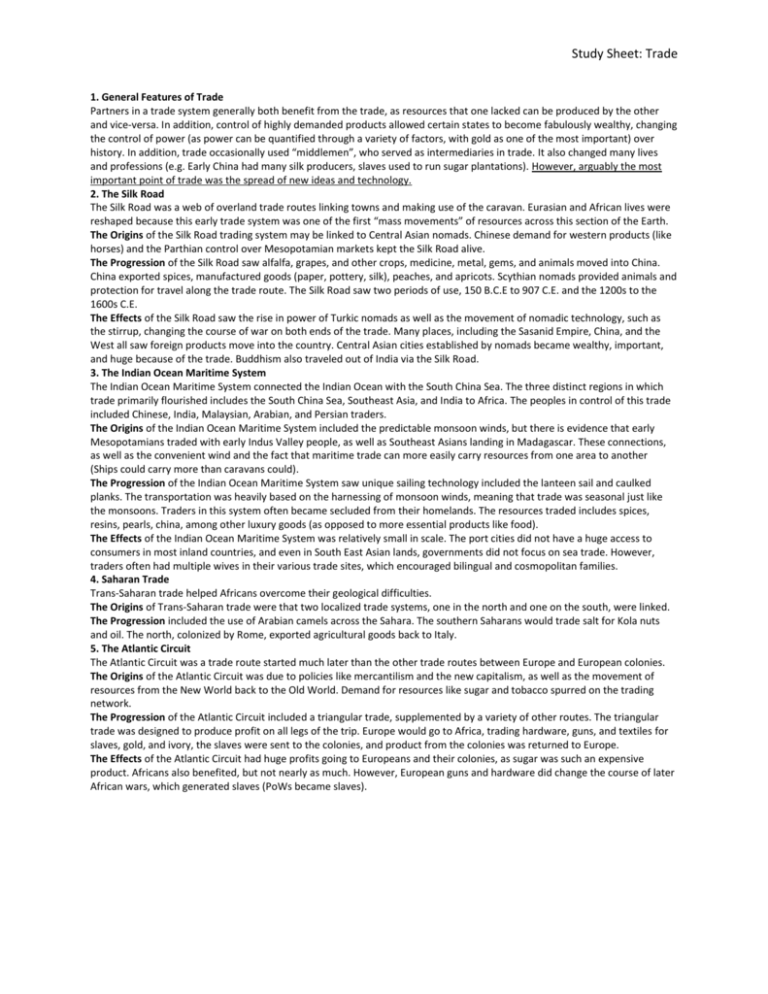
Study Sheet: Trade 1. General Features of Trade Partners in a trade system generally both benefit from the trade, as resources that one lacked can be produced by the other and vice-versa. In addition, control of highly demanded products allowed certain states to become fabulously wealthy, changing the control of power (as power can be quantified through a variety of factors, with gold as one of the most important) over history. In addition, trade occasionally used “middlemen”, who served as intermediaries in trade. It also changed many lives and professions (e.g. Early China had many silk producers, slaves used to run sugar plantations). However, arguably the most important point of trade was the spread of new ideas and technology. 2. The Silk Road The Silk Road was a web of overland trade routes linking towns and making use of the caravan. Eurasian and African lives were reshaped because this early trade system was one of the first “mass movements” of resources across this section of the Earth. The Origins of the Silk Road trading system may be linked to Central Asian nomads. Chinese demand for western products (like horses) and the Parthian control over Mesopotamian markets kept the Silk Road alive. The Progression of the Silk Road saw alfalfa, grapes, and other crops, medicine, metal, gems, and animals moved into China. China exported spices, manufactured goods (paper, pottery, silk), peaches, and apricots. Scythian nomads provided animals and protection for travel along the trade route. The Silk Road saw two periods of use, 150 B.C.E to 907 C.E. and the 1200s to the 1600s C.E. The Effects of the Silk Road saw the rise in power of Turkic nomads as well as the movement of nomadic technology, such as the stirrup, changing the course of war on both ends of the trade. Many places, including the Sasanid Empire, China, and the West all saw foreign products move into the country. Central Asian cities established by nomads became wealthy, important, and huge because of the trade. Buddhism also traveled out of India via the Silk Road. 3. The Indian Ocean Maritime System The Indian Ocean Maritime System connected the Indian Ocean with the South China Sea. The three distinct regions in which trade primarily flourished includes the South China Sea, Southeast Asia, and India to Africa. The peoples in control of this trade included Chinese, India, Malaysian, Arabian, and Persian traders. The Origins of the Indian Ocean Maritime System included the predictable monsoon winds, but there is evidence that early Mesopotamians traded with early Indus Valley people, as well as Southeast Asians landing in Madagascar. These connections, as well as the convenient wind and the fact that maritime trade can more easily carry resources from one area to another (Ships could carry more than caravans could). The Progression of the Indian Ocean Maritime System saw unique sailing technology included the lanteen sail and caulked planks. The transportation was heavily based on the harnessing of monsoon winds, meaning that trade was seasonal just like the monsoons. Traders in this system often became secluded from their homelands. The resources traded includes spices, resins, pearls, china, among other luxury goods (as opposed to more essential products like food). The Effects of the Indian Ocean Maritime System was relatively small in scale. The port cities did not have a huge access to consumers in most inland countries, and even in South East Asian lands, governments did not focus on sea trade. However, traders often had multiple wives in their various trade sites, which encouraged bilingual and cosmopolitan families. 4. Saharan Trade Trans-Saharan trade helped Africans overcome their geological difficulties. The Origins of Trans-Saharan trade were that two localized trade systems, one in the north and one on the south, were linked. The Progression included the use of Arabian camels across the Sahara. The southern Saharans would trade salt for Kola nuts and oil. The north, colonized by Rome, exported agricultural goods back to Italy. 5. The Atlantic Circuit The Atlantic Circuit was a trade route started much later than the other trade routes between Europe and European colonies. The Origins of the Atlantic Circuit was due to policies like mercantilism and the new capitalism, as well as the movement of resources from the New World back to the Old World. Demand for resources like sugar and tobacco spurred on the trading network. The Progression of the Atlantic Circuit included a triangular trade, supplemented by a variety of other routes. The triangular trade was designed to produce profit on all legs of the trip. Europe would go to Africa, trading hardware, guns, and textiles for slaves, gold, and ivory, the slaves were sent to the colonies, and product from the colonies was returned to Europe. The Effects of the Atlantic Circuit had huge profits going to Europeans and their colonies, as sugar was such an expensive product. Africans also benefited, but not nearly as much. However, European guns and hardware did change the course of later African wars, which generated slaves (PoWs became slaves).

